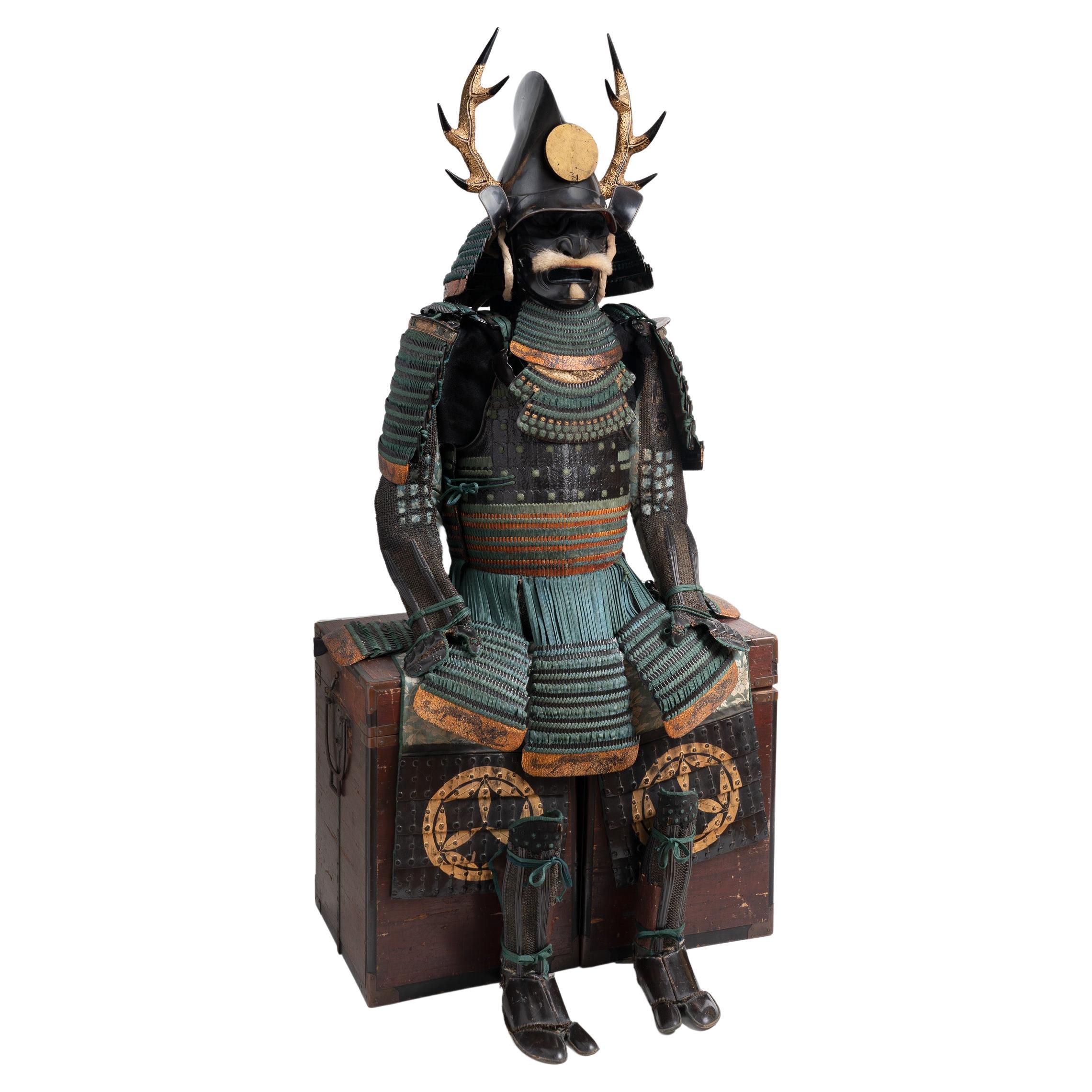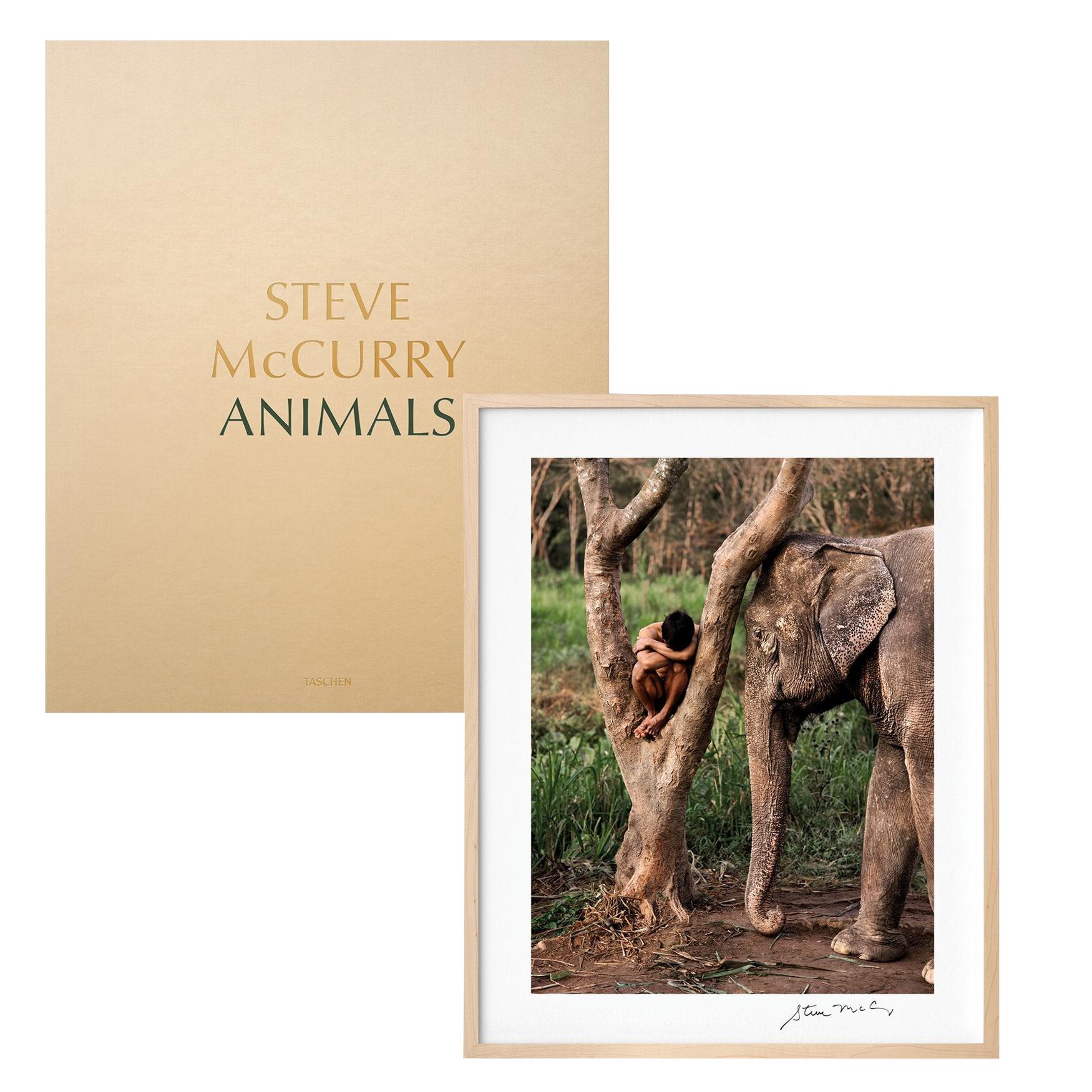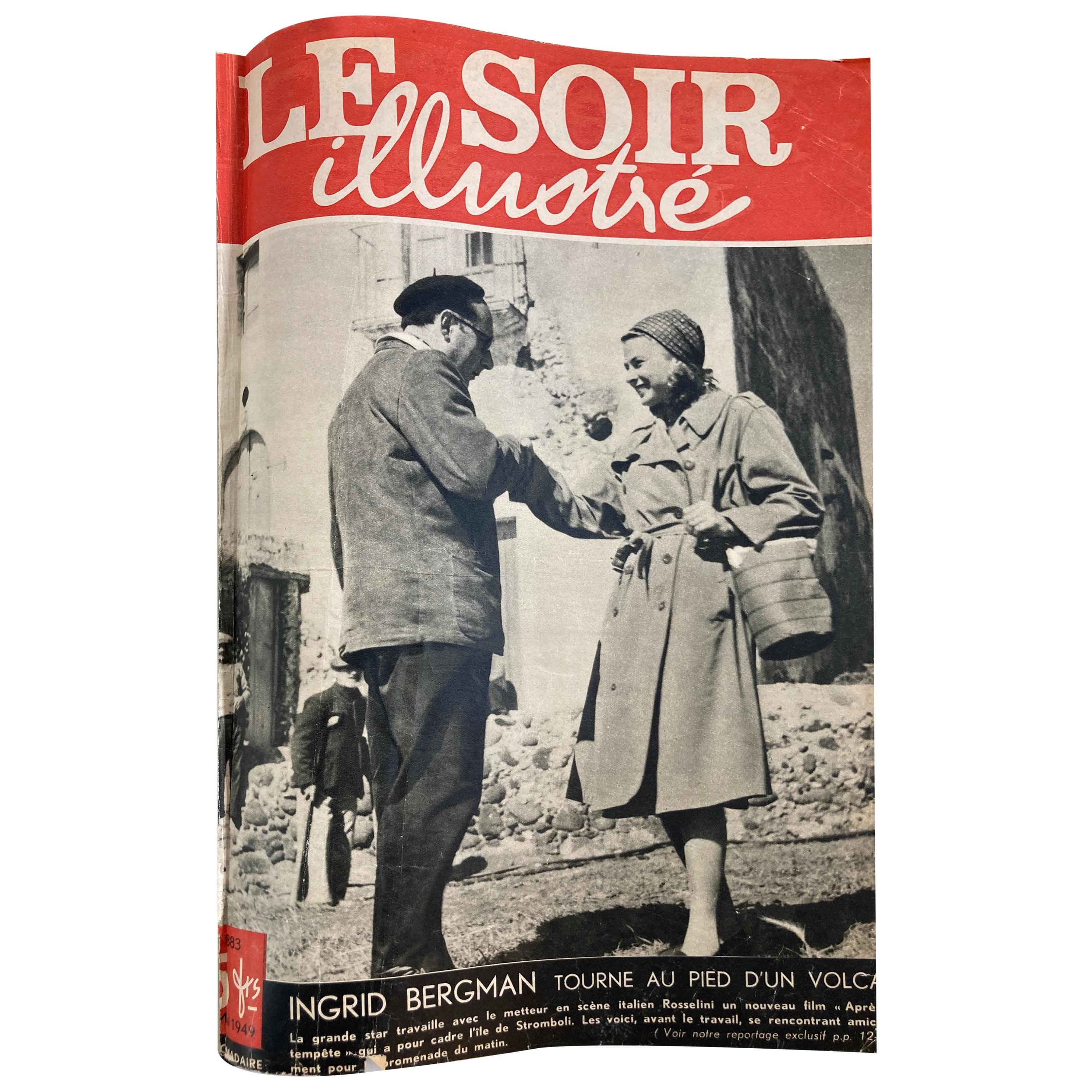Items Similar to Hon-kozane ni-mai do tosei gusoku
Want more images or videos?
Request additional images or videos from the seller
1 of 21
Hon-kozane ni-mai do tosei gusoku
About the Item
Hon-kozane ni-mai do tosei gusoku
Samurai armor in revival style
Edo Period, 17th to 18th century
Signature on kabuto: Jōshū jū Saotome Ietada
Kabuto [helmet]: A russet iron (tetsu sabiji) sixty-two plate kabuto, each mounted with twenty-five small tapered standing rivets (ko-boshi) of decreasing size; the front plate, larger than the others, is fitted with two lines of rivets, while the rear one is left empty, for a total of 1.550 rivets.
The typical "Saotome-byo", an extra rivet which is almost an additional signature of the Saotome armorers, is visible inside.
Maedate [helmet crest]: Kuwagata (stylized horns) with shakudo kuwagata-dai (support) fitted with three hanabishi (flower-shaped family crest) and a large gilt-wood peony
Menpō [mask]: A russet iron (tetsu sabiji) ressei-men (mask with fierce expression)
Dō [cuirass]: Ni-mai dō (made in two parts) with hon-kozane (true scale) construction. Stencilled leather plates with engraved shakudo borders, fine pierced kanamono (application) bearing a hanabishi.
Sode [shoulder guards]: Large type (ō-sode), with fine kanamono and decorations.
Kote [sleeves]: In russet iron, with a hanabishi on the back of the hand (tekko).
Haidate [thigh guard]: Of hakama type (full trousers), made of tied rectangular iron plates.
Suneate [shin guards]: Finished in black urushi lacquer.
Accessories: A saihai (commander’s baton); high-level kara-bitsu (storage box)
With its large sode (shoulder guards) and old-fashioned construction, the style of the armor is reminiscent of the medieval suits popular in the Edo period. This fashion for early style armour was firmly established when the eighth shogun Tokugawa Ieyoshi (1684 - 1750) promoted a revival of ancient weaponry, including swords and armor, to revitalize what he believed to be a decline in the nation's martial spirit.
The cuirass is crafted with hundreds of tiny plates joined together. This system, known as hon-kozane ("true scales"), was a complex, expensive, yet effective method of lacing together numerous small plates; it was used until the sixteenth century and then recovered during the Edo period for revival-style armor for high-ranking samurai.
Ietada, of which existed few generations, is considered to be the founder of the Saotome school, which takes its name from the village in the Hitachi province where it originated. According to the Meiko Zukan, the most important antique manuscript about Japanese armor, it was in fact created by Saotome Chikara, a samurai at the service of the Tagaya clan who started this activity after he became a ronin. The Tagaya clan were stripped of their 60,000 koku holdings after the Sekigahara battle due to their defection to the Uesugi clan, so it is probably after 1600 that Ietada - the name that Chikara choose to sign his works - founded the Saotome school, even if it is unclear how he managed to learn such skill in manufacturing helmets.
- Dimensions:Height: 19.69 in (50 cm)Width: 39.38 in (100 cm)Depth: 59.06 in (150 cm)
- Materials and Techniques:
- Place of Origin:
- Period:Late 17th Century
- Date of Manufacture:17th to 18th century
- Condition:
- Seller Location:Milano, IT
- Reference Number:1stDibs: LU4250236067192
About the Seller
5.0
Recognized Seller
These prestigious sellers are industry leaders and represent the highest echelon for item quality and design.
Established in 2005
1stDibs seller since 2018
10 sales on 1stDibs
Typical response time: 1 hour
- ShippingRetrieving quote...Ships From: Milano, Italy
- Return PolicyA return for this item may be initiated within 7 days of delivery.
More From This SellerView All
- Go-Mai Uchidashi Dō Tosei Gusoku Samurai Armor Decorated with an Embossed RabbitLocated in Milano, ITGo-mai uchidashi do tosei gusoku Samurai armor decorated with an embossed rabbit Edo period, 19th century This samurai armor is complete and original, with consistent elements...Category
Antique 19th Century Japanese Metalwork
MaterialsIron
- Dangae do tosei gusoku A blue-laced samurai armor with cuirass of double styleLocated in Milano, ITDangae do tosei gusoku A blue-laced samurai armor with cuirass of double style Edo Period, 18th century Kabuto [helmet]: Black lacquered eboshi-nari kabuto, in the form of this ...Category
Antique 18th Century Arms, Armor and Weapons
MaterialsIron
- Okitenugui Kabuto Samurai Helmet Shaped as a Head Towel Saika, Early Edo PeriodLocated in Milano, ITOkitenugui kabuto Samurai helmet shaped as a head towel Saika, early Edo period, 17th century The Haruta armorers who moved to Kii province in the early 17th century, took the name from the village where they worked, Saika, near Wakayama, possibly on request of the local daimyo, Asano Yukinaga, a great armour amateur. Specialised in the construction of plate helmets, they produced mainly two typologies of kabuto: one with six plates covered with a chrysanthemum-shaped plate on top and one shaped as a “head towel”, called okitenugui. The latter type of kabuto employs very heavy plates crafted in a curved manner and was improved in order to make it resistant to firearms. This okitenugui kabuto features some distinctive decorations of the Haruta school, including the application of cut-out iron elements, including eyebrows, washers and lozenge-shaped decorations on the sides. The ring on the top, however, is a rare feature and could be used to hold a small war flag.Category
Antique 17th Century Metalwork
MaterialsIron
- A Hizen Katana in koshiraeLocated in Milano, ITA Hizen Katana in koshirae Signed 肥前國河内大掾藤原正廣 Hizen kuni kawachi daijō Fujiwara Masahiro - Early Edo Period (1615-1867) - NBTHK Hozon Tōken - Nagasa [leng...Category
Antique 17th Century Japanese Arms, Armor and Weapons
MaterialsSteel
- Toppai kabuto, Signed Haruta Yoshimasa and dated 1802Located in Milano, ITToppai kabuto, Samurai helmet from the Kajiwara clan. Edo period, dated 1802. Signatures: 筑藩士官 梶原 景泰 命春田 昌芳造之 享和二年壬 秋也 Chikushū (?) Shikan (officer) Kajiwara Kageyasu (?) Mikoto (lo...Category
Antique Early 19th Century Japanese Arms, Armor and Weapons
MaterialsIron
- Samurai Mask with a Fierce Expression Ressei MenpoLocated in Milano, ITSamurai mask with a fierce expression Ressei Menpo DATE Edo period (1615 - 1867), 18th century A red lacquered high-level mask, with fierce (res...Category
Antique 18th Century Japanese Metalwork
MaterialsIron
You May Also Like
- Ashley Longshore: I Do Not Cook, I Do Not Clean, I Do Not Fly CommercialBy Rizzoli International PublicationsLocated in New York, NYAshley Longshore: I Do Not Cook, I Do Not Clean, I Do Not Fly Commercial Author Ashley Longshore, Contributions by Linda Fargo and Blake Lively and Diane von Furstenberg and Tommy Hilfiger New Orleans-based self-taught pop artist Ashley Longshore, known for her bold fashionista portraits and larger-than-life personality, has a massive art-cult following. I Do Not Cook, I Do Not Clean, I Do Not Fly Commercial highlights Ashley's colorful life story and showcases her bejeweled vibrant pop art. Ashley Longshore delivers exactly what her fans are clamoring for: a look at Ashley's big life, her audacious aphorisms, and of course her sumptuous, glittering art in sublime detail. Ashley Longshore's pop-art paintings are always daring; her art makes noise. On any given day, you may catch her in her New Orleans gallery painting with Blake Lively, talking art and fashion with Dapper Dan in New York, or on a remote island in Hawaii painting...Category
21st Century and Contemporary Books
MaterialsPaper
- Golf Oil Painting of Dr. William Laidlaw Purves by Hon. John CollierBy John CollierLocated in Oxfordshire, GBImpressive modern Golf Portrait, William Laidlaw Purves. Large oil on canvas of Dr. William Laidlaw Purves after the original oil painting by the Hon. John Collier (1850 - 1934), a prominent London artist. The painting is un-framed but is stretched and ready to hang, artist of this particular painting is unknown. The original painting now hangs at Royal St. George's, Sandwich. William Laidlaw Purves, oculist and obsessive golfer, was an Edinburgh born surgeon who worked in London, but remembered by most for his contributions to the golfing world. A very influential man, he was one of the key figures behind the spread of the game of golf in England towards the end of the 19th century. He won many important club trophies, the last being in 1914, aged 71 with a handicap of 3. He died at his home Hardwick Cottage, Wimbledon Common on 30th December 1917, and at the time he was a member of no fewer than 32 golf clubs. As a student Purves had played golf at Bruntsfield Links in Edinburgh and by the time of his London appointment he was a member of both the Honorable Company of Edinburgh Golfers and the Royal and Ancient Golf Club of St Andrews. Upon his move to London in 1874 he joined the London Scottish and Wimbledon Golf Club. The two clubs shortly separated into two separate clubs, The London Scottish Golf Club and the Wimbledon Golf Club, but both continued to play on Wimbledon Common. In 1882 the Wimbledon became the Royal Wimbledon Golf Club and Purves became an active committee member, later being elected Captain. As the two clubs also shared the Common with the public play was restricted, so together with a fellow Scot and keen amateur golfer (Henry Lamb...Category
2010s European Sporting Art Sports Equipment and Memorabilia
MaterialsCanvas
- Steve McCurry, Animals, Art Edition No. 1-100 ‘Chiang Mai, Thailand, 2010’Located in Los Angeles, CAFrom an elephant lovingly resting on his master’s shoulder to a dog led through the rubble of Kabul on the back of a bicycle, these images by Steve McCurry tell a thousand stories, e...Category
21st Century and Contemporary Books
MaterialsOther
- Le Soir Illustre, Mai 1949 to Sept 1949 French Magazines Paris FranceLocated in North Hollywood, CA26 issues casebound in buckram. Nos. 883 - 899, mai 1949 to sept 1949. Title: Le Soir Illustre, mai 1949 to sept 1949. Paris France. Publication Date: 1949 French text.Category
Early 20th Century French French Provincial Books
MaterialsPaper
- Vintage Do Not Pass Metal Traffic SignsLocated in Topeka, KSCool vintage “Do Not Pass” metal traffic signs. We have two offered and have priced them individually. These are in wonderful vintage condition mad...Category
20th Century North American Industrial Wall-mounted Sculptures
MaterialsAluminum
- Picasso in Antibes by Dor De La Souchère, 1960By Romuald Dor de la Souchère 1Located in London, GBPicasso in Antibes by Dor De La Souchère. Published by Perry Lund, Humphries & Company Ltd. 1960. First edition. Photographs by Marianne Greenwood, ...Category
Vintage 1960s British Modern Books
MaterialsPaper
Recently Viewed
View AllMore Ways To Browse
Samurai Suit
Japanese Menpo Mask
Medieval Suit Of Armour
Samurai Armor Mask
Tie Storage Box
Japanese Samurai Mask
Samurai Helmet Box
Iron Helmet
Black Silk Pants Mens
Samurai Sword Antique
Shakudo Box
Plate Armour
Japanese Samurai Sword
Used Hakama
Small Antique Leather Boxes
Tiny Rectangular Wood
Iron Flower Box
Japanese 1600





